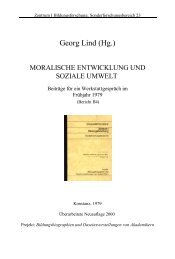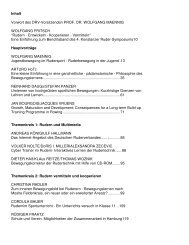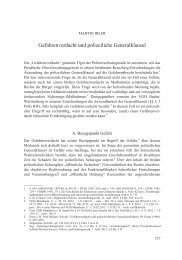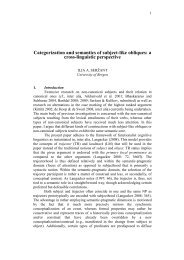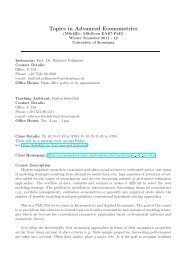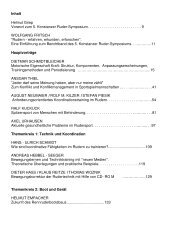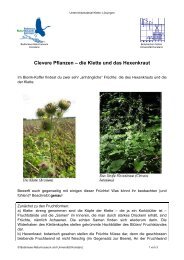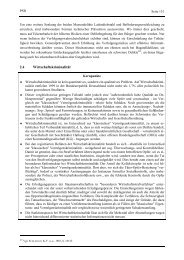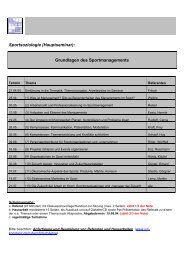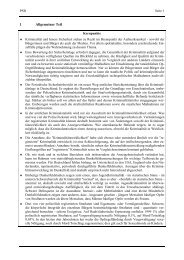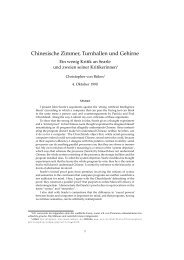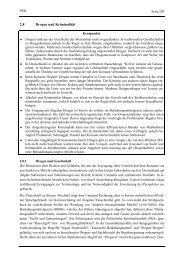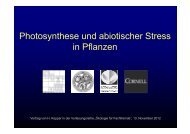Book of Abstracts Book of Abstracts - Universität Konstanz
Book of Abstracts Book of Abstracts - Universität Konstanz
Book of Abstracts Book of Abstracts - Universität Konstanz
You also want an ePaper? Increase the reach of your titles
YUMPU automatically turns print PDFs into web optimized ePapers that Google loves.
High resolution electron ionization study <strong>of</strong> helium-clusters<br />
S. Denifl 1 , S. Ptasińska 1 , F. Martinez 2 , K. Głuch 3 , S. Feil 1 , P. Scheier 1 , T. D. Märk 1<br />
A - 22<br />
1 Insitut für Ionenphysi,, <strong>Universität</strong> Innsbruck, Technikerstrasse 25, 6020 Innsbruck, Austria<br />
2 Institut für Physik, Ernst Moritz Arndt <strong>Universität</strong> Greifswald, Domstrasse 10a,17487 Greifswald,<br />
Germany<br />
3 Institute <strong>of</strong> Physics, Maria Curie-Sklodowska University, Pl. Marii Curie-Sklodowskiej 1, 20-031 Lublin,<br />
Poland<br />
After many years <strong>of</strong> research the determination and interpretation <strong>of</strong> appearance energies<br />
(AE’s) for clusters using electron impact ionization is still difficult and involves large error bars.<br />
The reasons for this are a number <strong>of</strong> technical obstacles to prepare electrons with high-energy<br />
resolution. In addition we are confronted with a complicated physical situation <strong>of</strong> a reaction<br />
complex involving a quantum mechanical many body system. The use <strong>of</strong> photoionization<br />
sometimes appears to be less difficult but nevertheless the AE values obtained are not directly<br />
comparable to those obtained by electron impact studies. Both processes are intrinsically<br />
different, because the transition complexes in the ionization process are not the same.<br />
This work presents the high resolution study <strong>of</strong> the threshold behavior for small helium cluster<br />
ions. The crossed electron/cluster beams apparatus used for these measurements consists <strong>of</strong> a<br />
cluster source, a hemispherical electron monochromator and a quadrupole mass spectrometer. A<br />
standard home-built hemispherical electron analyzer produces electrons with a typical energy<br />
distribution <strong>of</strong> 150 meV. The helium clusters are produced by supersonic expansion in a cluster<br />
source which can be cooled down to 8.5 K. Previously already all other rare gases (Ne, Ar, Kr,<br />
Xe), H2-, D2-, N2- and N2O-clusters have been studied with the present experimental setup<br />
(except a different cluster source was used). The data evaluation is basing on an extension <strong>of</strong><br />
Wannier’s law for the ionization <strong>of</strong> atoms towards the case <strong>of</strong> clusters. The present results for<br />
helium cluster up to size n = 10 are compared with those <strong>of</strong> previous experiments with small<br />
helium clusters using electron impact [1] or photon impact [2], respectively.<br />
This work was supported by FWF, Wien, Austria, and the European Commission,<br />
Brussels.<br />
References<br />
[1] R. Fröchtenicht, U. Henne, J. P. Toennis, A. Ding, M. Fieber-Erdmann, T. Drewello, J. Chem.<br />
Phys. 104, 2548 (1996).<br />
[2] B. E. Callicoat, K. Förde, L. F. Jung, T. Ruchti, K. C. Janda, J. Chem. Phys. 109, 10195 (1998).<br />
131



